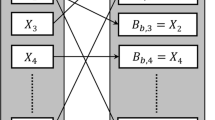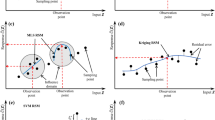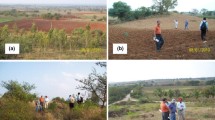Abstract
Probabilistic methods are the most efficient methods to account for different types of uncertainties encountered in the estimated rock properties required for the stability analysis of rock slopes and tunnels. These methods require estimation of various parameters of probability distributions like mean, standard deviation (SD) and distributions types of rock properties, which requires large amount of data from laboratory and field investigations. However, in rock mechanics, the data available on rock properties for a project are often limited since the extents of projects are usually large and the test data are minimal due to cost constraints. Due to the unavailability of adequate test data, parameters (mean and SD) of probability distributions of rock properties themselves contain uncertainties. Since traditional reliability analysis uses these uncertain parameters (mean and SD) of probability distributions of rock properties, they may give incorrect estimation of the reliability of rock slope stability. This paper presents a method to overcome this limitation of traditional reliability analysis and outlines a new approach of rock mass characterization for the cases with limited data. This approach uses Sobol’s global sensitivity analysis and bootstrap method coupled with augmented radial basis function based response surface. This method is capable of handling the uncertainties in the parameters (mean and SD) of probability distributions of rock properties and can include their effect in the stability estimates of rock slopes. The proposed method is more practical and efficient, since it considers uncertainty in the statistical parameters of most commonly and easily available rock properties, i.e. uniaxial compressive strength and Geological Strength Index. Further, computational effort involved in the reliability analysis of rock slopes of large dimensions is comparatively smaller in this method. Present study also demonstrates this method through reliability analysis of a large rock slope of an open pit gold mine in Karnataka region of India. Results are compared with the results from traditional reliability analysis to highlight the advantages of the proposed method. It is observed that uncertainties in probability distribution type and its parameters (mean and SD) of rock properties have considerable effect on the estimated reliability index of the rock slope and hence traditional reliability methods based on the parameters of probability distributions estimated using limited data can make incorrect estimation of rock slope stability. Further, stability of the rock slope determined from proposed approach based on bootstrap method is represented by confidence interval of reliability index instead of a fixed value of reliability index as in traditional methods, providing more realistic estimates of rock slope stability.











Similar content being viewed by others
Abbreviations
- SD:
-
Standard deviation
- UCS:
-
Uniaxial compressive strength
- GSI:
-
Geological Strength Index
- RBF:
-
Radial basis function
- FOS:
-
Factor of safety
- CCDF:
-
Complimentary cumulative distribution function
- \({X_1},~{X_2},~{X_3}, \ldots ,{X_N}\) :
-
Original data set with N observations
- \({\bar {X}_N}\) :
-
Mean of original data set
- \({S_N}\) :
-
SD of original data set
- \({{\varvec{B}}_{\varvec{j}}}\) :
-
jth bootstrap sample set of input parameter X
- \({N_{\text{s}}}\) :
-
Total number of bootstraps
- \(k\) :
-
No. of quasi-random samples for estimation of Sobol indices
- AIC:
-
Akaike Information Criterion
- AICD :
-
Akaike Information Criterion value associated with distribution D
- \({L_D}\) :
-
Maximum likelihood estimator of the data set associated with the distribution D
- \({K_D}\) :
-
Number of parameters required to fully characterize the distribution D
- \({\mu _{{\text{AI}}{{\text{C}}_D}}}\) :
-
Mean AIC value of distribution D
- \({\sigma _{{\text{AI}}{{\text{C}}_D}}}\) :
-
SD of AIC value of distribution D
- \({\bar {B}_i}\) :
-
Mean of ith bootstrap sample
- \({S_i}\) :
-
SD of ith bootstrap sample
- \({\left[ {{{\bar {X}}_{{N_{\text{s}}}}}} \right]_{{\text{mean}}}}\) :
-
Mean of Ns bootstrap sample means
- \({\sigma _{{{\bar {X}}_{{N_{\text{s}}}}}}}\) :
-
SD of Ns bootstrap sample means
- \({\left[ {{S_{{N_{\text{s}}}}}} \right]_{{\text{mean}}}}\) :
-
Mean of Ns bootstrap sample SDs
- \({\sigma _{{S_{{N_{\text{s}}}}}}}\) :
-
SD of Ns bootstrap sample SDs
- MC:
-
Monte Carlo
- PDF:
-
Probability density function
- FEM:
-
Finite element method
- FDM:
-
Finite difference method
- JCond 89 :
-
Joint condition factor of RMR 89
- LH:
-
Latin hypercube
- \(g({\varvec{X}})\) :
-
Performance function with X vector as input
- \(\phi (r)\) :
-
Radial basis function
- \({P_j}({\varvec{X}})\) :
-
Monomial terms of augmented polynomial P (x)
- \({\lambda _i}\) :
-
Unknown constants associated with ith RBF
- \({b_j}\) :
-
Unknown coefficients
- \(r\) :
-
Euclidean norm (distance) of vector X from Xi
- \({r_0}\) :
-
Radius of compact support of RBF
- \(t\) :
-
r/r0
- LOOCV:
-
Leave-one-out cross-validation error
- \({y_i}\) :
-
Output obtained from \(g({{\varvec{X}}_{\varvec{i}}})\)
- n :
-
Number of LH samples drawn from input space
- HDMR:
-
High dimensional model representation
- \({S_i}\) :
-
First-order Sobol index for ith input parameter
- \({S_{{T_i}}}\) :
-
Total effects Sobol index for ith input parameter
- \({{\varvec{X}}_{\sim i}}\) :
-
Input vector having all components except the ith component
- RQD:
-
Rock quality designation
- RMR:
-
Rock mass rating
- \({E_i}\) :
-
Young’s modulus
- \(\nu\) :
-
Poisson’s ratio
- \({\sigma _t}\) :
-
Tensile strength
- \(\gamma\) :
-
Unit weight of rock mass
- SSR:
-
Shear strength reduction
- \({m_i}\) :
-
Hoek–Brown constant for intact rock
- NSE:
-
Nash–Sutcliffe efficiency
- PBIAS:
-
Percent bias
- RSR:
-
Ratio of root-mean-square error to SD of observed data
- R :
-
Reliability index
- \({\mu _{{\text{FOS}}}}\) :
-
Mean FOS for obtained from single bootstrap sample as input
- \({V_{{\text{FOS}}}}\) :
-
Coefficient of variation of FOS for obtained from single bootstrap sample as input
References
Akaike H (1973) Information theory and an extension of the maximum likelihood principle. In: Petrov BN, Csáki F (eds) 2nd International symposium on information theory, Tsahkadsor, Armenia, USSR, September 2–8, 1971, Akadémiai Kiadó, Budapest, pp 267–281
Basarir H, Akdağ S, Karrech A, Özyurt M (2016) The estimation of rock mass strength properties using probabilistic approaches and quantified GSI chart. In: ISRM Eurock 2016
Bieniawski ZT (1989) Engineering rock mass classifications. Wiley, New York
Bowman AW, Azzalini A (1997) Applied smoothing techniques for data analysis: the kernel approach with s-plus illustrations. Oxford University Press, New York
Dadashzadeh N, Duzgun HSB, Yesiloglu-Gultekin N (2017) Reliability-based stability analysis of rock slopes using numerical analysis and response surface method. Rock Mech Rock Eng 50(8):2119–2133
De Rocquigny E (2012) Modelling under risk and uncertainty: an introduction to statistical, phenomenological and computational methods. Wiley, New York
Duzgun HSB, Bhasin RK (2009) Probabilistic stability evaluation of Oppstadhornet rock slope Norway. Rock Mech Rock Eng 42(5):729–749
Duzgun HSB, Pasamehmetoglu AG, Yucemen MS (1995) Plane failure analysis of rock slopes: a reliability approach. Int J Surf Min Reclam Environ 9(1):1–6
Duzgun HSB, Yuceman MS, Karpuz CA (2002) A probabilistic model for the assessment of uncertainties in the shear strength of rock discontinuities. Int J Rock Mech Min Sci Geomech Abstr 39:743–754
Efron B (1979) Bootstrap methods: another look at the jackknife. Ann Stat 7(1):1–26
Fang H, Horstemeyer MF (2006) Global response approximation with radial basis functions. Eng Optim 38(4):407–424
Helton JC (1993) Uncertainty and sensitivity analysis techniques for use in performance assessment for radioactive waste disposal. Reliab Eng Syst Saf 42:327–367
Hoek E, Diederichs MS (2006) Empirical estimation of rock mass modulus. Int J Rock Mech Min Sci 43(2):203–215
Hoek E, Carranza-Torres C, Corkum B (2002) Hoek–Brown failure criterion—2002 edition. In: Proceedings of the 5th North American rock mechanics symposium, Toronto, Canada, pp 267–273
Hoek E, Carter TG, Diederichs MS (2013) Quantification of the Geological Strength Index chart. In: Paper prepared for presentation at the 47th US rock mechanics/geomechanics symposium held in San Francisco
ISRM (1981) Rock characterization, testing and monitoring. ISRM suggested methods. Pergamon Press, New York
Itasca (2011) FLAC—Fast Lagrangian analysis and continua, version 7.0. Itasca Consulting Group, Inc., Minneapolis
Jiang Q, Zhong S, Cui J, Feng XT, Song L (2016) Statistical characterization of the mechanical parameters of intact rock under triaxial compression: an experimental proof of the Jinping marble. Rock Mech Rock Eng 49(12):4631–4646
Krishnamurthy T (2003) Response surface approximation with augmented and compactly supported radial basis functions. In: Proceedings of 44th aiaa/asme/asce/ahs/asc structures, structural dynamics, and materials conference, Virginia
Li DQ, Jiang SH, Cao ZJ, Zhou CB, Li XY, Zhang LM (2015a) Efficient 3-D reliability analysis of the 530 m high abutment slope at Jinping I hydropower station during construction. Eng Geol 195:269–281
Li DQ, Tang XS, Phoon KK (2015b) Bootstrap method for characterizing the effect of uncertainty in shear strength parameters on slope reliability. Reliab Eng Syst Saf 140:99–106
Luo Z, Atamturktur S, Juang CH (2013) Bootstrapping for characterizing the effect of uncertainty in sample statistics for braced excavations. J Geotech Geoenviron Eng 139(1):13–23
Madani N, Yagiz S, Adoko AC (2018) Spatial mapping of the rock quality designation using multi-Gaussian Kriging method. Minerals 8(11):530
Matlab 9.0 (2016) The MathWorks, Inc., Natick, Massachusetts
Mauldon M, Ureta J (1996) stability analysis of rock wedges with multiple sliding surfaces. Int J Rock Mech Min Sci Geomech Abstr 33:51–66
Montgomery DC (2001) Design and analysis of experiments. Wiley, New York
Morelli GL (2015) Variability of the GSI index estimated from different quantitative methods. Geotech Geol Eng 33:983–995
Moriasi DN, Arnold JG, Van LMW, Bingner RL, Harmel RD, Veith TL (2007) Model evaluation guidelines for systematic quantification of accuracy in watershed simulations. Trans ASABE 50(3):885–900
Most T, Knabe T (2010) Reliability analysis of the bearing failure problem considering uncertain stochastic parameters. Comput Geotech 37(3):299–310
Pain A, Kanungo DP, Sarkar S (2014) Rock slope stability assessment using finite element based modelling—examples from the Indian Himalayas. Geomech Geoeng 00:1–16
Pandit B, Babu GLS (2017) Reliability-based robust design for reinforcement of jointed rock slope. Georisk Assess Manag Risk Eng Syst Geohazards 12(2):152–168
Pandit B, Tiwari G, Latha GM, Babu GLS (2018) Stability analysis of a large gold mine open pit slope using advanced probabilistic method. Rock Mech Rock Eng 51(7):2153–2174
Ramamurthy T (2013) Engineering in rocks for slopes, foundations and tunnels. Prentice Hall of India (Pubs.), New Delhi
Saltelli A (2002) Making best use of model valuations to compute sensitivity indices. Comput Phys Commun 145:280–297
Saltelli A, Ratto M, Andres T, Campolongo F, Cariboni J, Gatelli D, Saisana M, Tarantola S (2008) Global sensitivity analysis. The primer. Wiley, New York
Tiwari G, Latha GM (2016) Design of rock slope reinforcement: an Himalayan case study. Rock Mech Rock Eng 49(6):2075–2097
Tiwari G, Latha GM (2017) Reliability analysis of jointed rock slope considering uncertainty in peak and residual strength parameters. Bull Eng Geol Environ 78(2):913–930
U.S. Army Corps of Engineers (1999) Risk-based analysis in geotechnical engineering for support of planning studies, engineering and design. Department of Army, Washington
Wang Q, Horstemeyer H, Shen L (2016) Reliability analysis of tunnels using a metamodeling technique based on augmented radial basis functions. Tunn Undergr Sp Technol 56:45–53
Wu Z (1995) Compactly supported positive definite radial function. Adv Comput Math 4:283–292
Author information
Authors and Affiliations
Corresponding author
Additional information
Publisher’s Note
Springer Nature remains neutral with regard to jurisdictional claims in published maps and institutional affiliations.
Appendix
Appendix
Monte Carlo method to determine first order and total effect Sobol indices (Saltelli 2002).
-
1.
A quasi-random number was generated in form of matrix of size (k, 2d), where k is called base sample and d is the dimension of the input vector. k in this study was taken as 105. Quasi-random numbers were generated in the Matlab 2016. Further, two matrices A and B are defined having half of the sample.
$$A=\left[ {\begin{array}{*{20}{l}} {X_{1}^{{(1)}}}&{X_{2}^{{(1)}}}& \cdots &{X_{i}^{{(1)}}}& \cdots &{X_{d}^{{(1)}}} \\ \vdots & \vdots & \ddots & \vdots & \ddots & \vdots \\ {X_{1}^{{(k)}}}&{X_{2}^{{(k)}}}& \cdots &{X_{i}^{{(k)}}}& \cdots &{X_{d}^{{(k)}}} \end{array}} \right]$$(17)$$B=\left[ {\begin{array}{*{20}{l}} {X_{{d+1}}^{{(1)}}}&{X_{{d+2}}^{{(1)}}}& \cdots &{X_{{d+i}}^{{(1)}}}& \cdots &{X_{{2d}}^{{(1)}}} \\ \vdots & \vdots & \ddots & \vdots & \ddots & \vdots \\ {X_{{d+1}}^{{(k)}}}&{X_{{d+2}}^{{(k)}}}& \cdots &{X_{{d+i}}^{{(k)}}}& \cdots &{X_{{2d}}^{{(k)}}} \end{array}} \right].$$(18) -
2.
Another matrix Ci is defined which contains all elements of B, except the ith column, which is taken from A.
$${C_i}=\left[ {\begin{array}{*{20}{c}} {X_{{d+1}}^{{(1)}}}&{X_{{d+2}}^{{(1)}}}& \cdots &{X_{i}^{{(1)}}}& \cdots &{X_{{2d}}^{{(1)}}} \\ \vdots & \vdots & \ddots & \vdots & \ddots & \vdots \\ {X_{{d+1}}^{{(k)}}}&{X_{{d+2}}^{{(k)}}}& \cdots &{X_{i}^{{(k)}}}& \cdots &{X_{{2d}}^{{(k)}}} \end{array}} \right].$$(19) -
3.
Compute the output from of A, B and Ci matrices to obtain column matrix of outputs YA, YB and \({Y_{{C_i}}}\).
-
4.
Now, the first-order sensitivity index Si and total effects \({S_{{T_i}}}\) are calculated via Eqs. (20) and (21):
$${S_i}=\frac{{\left( {\frac{1}{k}} \right)\mathop \sum \nolimits_{{j=1}}^{k} y_{A}^{{(j)}}y_{{{C_i}}}^{{(j)}} - f_{0}^{2}}}{{\left( {\frac{1}{k}} \right)\mathop \sum \nolimits_{{j=1}}^{k} {{\left( {y_{A}^{{(j)}}} \right)}^2} - f_{0}^{2}}},$$(20)$${S_{{T_i}}}=1 - \frac{{\left( {\frac{1}{k}} \right)\mathop \sum \nolimits_{{j=1}}^{k} y_{B}^{{(j)}}y_{{{C_i}}}^{{(j)}} - f_{0}^{2}}}{{\left( {\frac{1}{k}} \right)\mathop \sum \nolimits_{{j=1}}^{k} {{\left( {y_{A}^{{(j)}}} \right)}^2} - f_{0}^{2}}},$$(21)where \(y_{A}^{{(j)}}\), \(y_{B}^{{(j)}}\) and \(y_{{{C_i}}}^{{(j)}}\) are the jth element of column vectors YA, YB and \({Y_{{C_i}}}\), and
$$f_{0}^{2}=~{\left( {\frac{1}{k}\mathop \sum \limits_{{j=1}}^{k} y_{A}^{{(i)}}} \right)^2}.$$(22)
Rights and permissions
About this article
Cite this article
Pandit, B., Tiwari, G., Latha, G.M. et al. Probabilistic Characterization of Rock Mass from Limited Laboratory Tests and Field Data: Associated Reliability Analysis and Its Interpretation. Rock Mech Rock Eng 52, 2985–3001 (2019). https://doi.org/10.1007/s00603-019-01780-1
Received:
Accepted:
Published:
Issue Date:
DOI: https://doi.org/10.1007/s00603-019-01780-1




